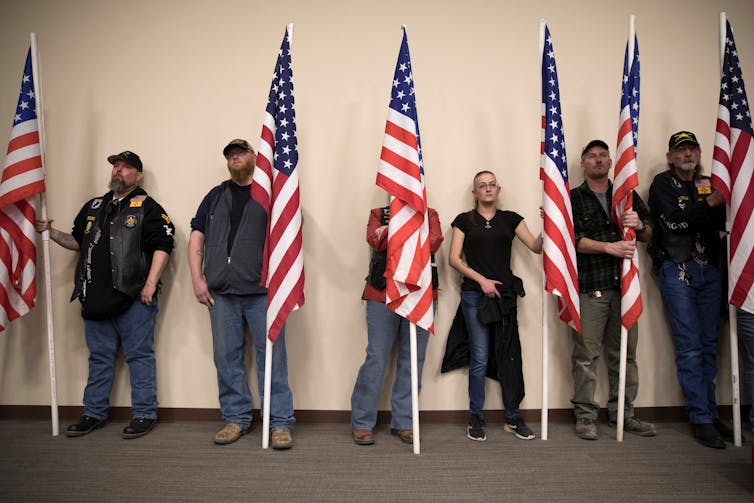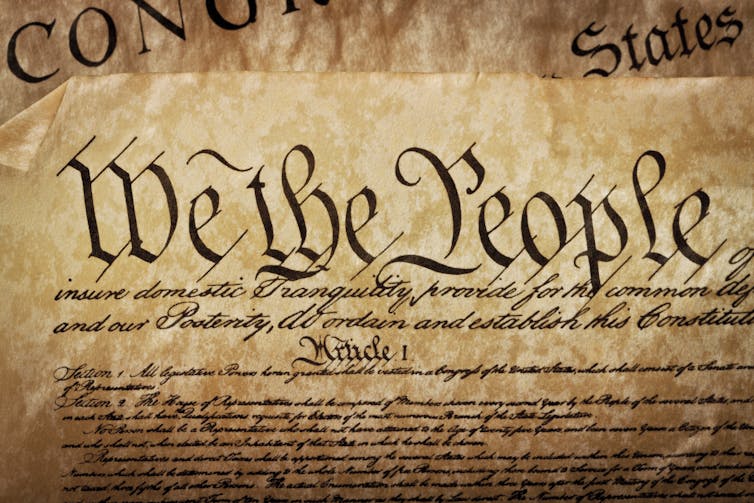Sanctuaries protecting gun rights and the unborn challenge the legitimacy and role of federal law
- Written by John E. Finn, Professor Emeritus of Government, Wesleyan University
In June 2019, the small Texas town of Waskom[1] declared itself a “Sanctuary City for the Unborn.”
Waskom’s city council passed an ordinance that labels groups – like Planned Parenthood, NARAL and others – that perform abortions or assist women in obtaining them “criminal organizations.”
The ordinance borrows from a similar resolution passed in March by Roswell, New Mexico[2]. Unlike the merely rhetorical Roswell resolution, however, the Texas law bans most abortions within city limits. There are no abortion providers in the town, so it is not clear how the town would enforce the ordinance. It might, perhaps, deter an organization from opening a clinic.
These “sanctuaries for life” join other sanctuaries popping up across the country that challenge federal law and how we understand its power and role in the states and the lives of Americans.
Gun owners’ rights
The rapid rise of anti-abortion sanctuaries has a precedent in the growth of so-called Second Amendment sanctuaries.
Second Amendment sanctuaries are partly a response to proposed “red flag” laws[3]. Such laws authorize state courts to issue emergency protection orders, which allow police to temporarily confiscate firearms from a person who presents a danger to others or themselves.
Second Amendment sanctuaries are a booming business. Five states and at least 75 cities and counties have designated themselves as Second Amendment sanctuaries. They refuse to enforce background checks and to comply with emergency protection orders[4].
 Supporters of the Second Amendment sanctuary status attend the county commission meeting in Grants, New Mexico, February 28, 2019.
REUTERS/Adria Malcolm[5]
Supporters of the Second Amendment sanctuary status attend the county commission meeting in Grants, New Mexico, February 28, 2019.
REUTERS/Adria Malcolm[5]
Roots in 19th century
Sanctuaries are not new.
A sanctuary is a state, a county or a town where local officials refuse to enforce federal laws of one sort or another. Its earliest versions in the United States trace to the Fugitive Slave Act of 1850[6], which required the capture and return of runaway slaves, and the anti-slavery abolitionist movement of the 1860s[7].
Most recently, Sanctuaries for Life and Second Amendment sanctuaries build on the sanctuary cities movement[8] that has flourished in response to President Donald Trump’s anti-immigration policies.
Those in turn built upon a similar trend in the 1980s[9], when some churches declared themselves sanctuaries for refugees fleeing repressive Central and South American governments supported by the United States.
From those who wanted to free slaves to those who want to arm themselves, this history tells us that both liberals and conservatives have tried to thwart enforcement of some federal laws.
Immunity from federal law
Although they use similar language, not all sanctuaries are the same, constitutionally. The differences concern what “sanctuary” means, what it requires and what those who use the word think its effects will be.
Fundamentally, sanctuaries claim immunity from federal laws and policies they think violate the Constitution or some other immutable law or principle of justice. Speaking as a constitutional scholar[10], I would note that these definitions are more political than legal arguments.
Sanctuaries do rest, however, on a particular and controversial – but not necessarily mistaken – understanding of what the Constitution means, as well as who has responsibility for determining its meaning.
The Waskom ordinance[11], for example, holds that “The Supreme Court erred in Roe v. Wade[12] when it said that pregnant women have a constitutional right to abort their pre-born children.”
The Personhood Alliance[13] similarly argues, “A Sanctuary City for Life uses its 10th Amendment power to protect the welfare, safety, and health of its people, born and pre-born, by ignoring the unjust, unconstitutional Roe decision and all its precedents.”
The assertion that Roe v. Wade is wrong constitutionally is debatable. But it is not out of bounds in a healthy constitutional democracy. Anyone is free to declare that they believe Roe v. Wade is wrong and should be overturned.
Likewise, a sanctuary proclamation, like the Roswell declaration, that makes a symbolic claim about federal law or about what the Constitution really means does not itself violate the Constitution. Such claims are a vital part of civic and constitutional debate in a healthy constitutional democracy.
And if the point is simply to refuse to assist federal officials in enforcing federal law, then that too probably is not unconstitutional. In Printz v. United States[14] (1997), the Supreme Court held that federal officials cannot force state and local officials to enforce federal law.
 At their best, the author writes, sanctuary movements are a sign of a strong and vibrant constitutional community. At their worst, they subvert the Constitution.
Shutterstock[15]
At their best, the author writes, sanctuary movements are a sign of a strong and vibrant constitutional community. At their worst, they subvert the Constitution.
Shutterstock[15]
Constitutional problems
On the other hand, some sanctuary movements violate the supremacy clause in Article 6 of the Constitution[16], which says that the federal constitution and federal laws trump state laws.
So a sanctuary movement that claims to nullify federal laws it finds objectionable raises constitutional problems. So too do assertions of a right to obstruct federal law or to impede the exercise of federally guaranteed rights and liberties.
The Sanctuaries for Life movement, for example, encourages communities to pass[17] “ordinances and statutes that prevent abortions from being performed and/or funded within the jurisdiction.” That goes well beyond what the Constitution’s supremacy clause permits.
Similarly, Second Amendment sanctuaries that reject all regulations on firearms, whether federal, state or local, also reach well beyond the limits of healthy constitutional dissent.
Before the Second Amendment sanctuary movement had a name, several states, including Missouri, Montana and Kansas, had passed or tried to pass legislation that invalidated various federal gun control initiatives.
In 2013, for example, the Missouri State House[18] passed a law that purported to nullify all federal gun control legislation in the state. The law, vetoed by Governor Jay Nixon[19], would have made it a crime for federal officers to enforce federal gun legislation in the state.
At their best, sanctuary movements are a sign of a strong and vibrant constitutional community, a visible sign of what I have called the “Civic Constitution.”[20] Under the Civic Constitution, questions concerning the meaning and application of constitutional principles to public life are the responsibility of all citizens and not just of judges.
In its worst forms, however, a sanctuary movement subverts the Constitution by denying its very authority.
The difference between sanctuary sense and nonsense will not always be obvious or easy to discern. And it certainly does not turn on whether underlying politics are liberal or conservative.
Rather, it turns on challenging – and contentious – questions about what the Constitution really means, and who gets to decide what it means.
References
- ^ town of Waskom (www.foxnews.com)
- ^ resolution passed in March by Roswell, New Mexico (www.washingtonexaminer.com)
- ^ “red flag” laws (www.nytimes.com)
- ^ emergency protection orders (www.salon.com)
- ^ REUTERS/Adria Malcolm (pictures.reuters.com)
- ^ Fugitive Slave Act of 1850 (avalon.law.yale.edu)
- ^ anti-slavery abolitionist movement of the 1860s (www.loc.gov)
- ^ sanctuary cities movement (www.nytimes.com)
- ^ a similar trend in the 1980s (theconversation.com)
- ^ Speaking as a constitutional scholar (kansaspress.ku.edu)
- ^ Waskom ordinance (www.documentcloud.org)
- ^ Roe v. Wade (www.oyez.org)
- ^ The Personhood Alliance (personhood.org)
- ^ Printz v. United States (www.oyez.org)
- ^ Shutterstock (www.shutterstock.com)
- ^ supremacy clause in Article 6 of the Constitution (www.law.cornell.edu)
- ^ encourages communities to pass (personhood.org)
- ^ the Missouri State House (rowman.com)
- ^ The law, vetoed by Governor Jay Nixon (www.cnn.com)
- ^ “Civic Constitution.” (kansaspress.ku.edu)
Authors: John E. Finn, Professor Emeritus of Government, Wesleyan University

